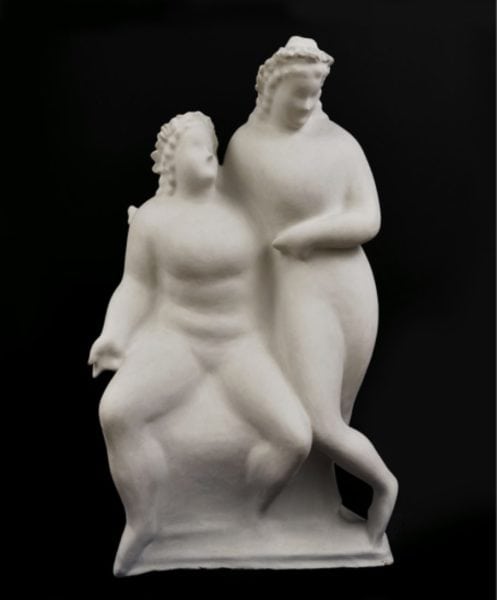Two Circus Women, 5 foot Lifetime Model for Lincoln Center, Circa 1928–1929
Elie NadelmanPapier-mâché and plaster
59 × 35 × 21 inches
Provenance
The artist, Riverdale, New York
Estate of the artist, by descent
Private collection, Scarsdale, New York
Alternative Titles:
Two Female Nudes
Two Women
Circus figures and entertainers have been represented in the visual arts for centuries. However, their popularity as a subject increased significantly during the nineteenth century, particularly in Paris. Phillip Denis Cate documented the burgeoning circus craze and defined the various types of spectacles from the big single-ring of professionals, to young aristocratic amateur shows, and even the itinerant performers known as saltimbanques or forains. Many artists, who themselves were living on the fringe of society felt a kinship with these clowns, acrobats, and unusual characters. Picasso, for example, depicted these figures for their contemplative disposition – so at odds with their public personas – and “as metaphors of . . . isolation”. Additionally, artists were drawn to this theme for the sense of mystery and eccentricity surrounding the performers. Still others were attracted by the amazing feats and displays of pure physical strength, equated at times with ancient Greek athletes. Cate noted examples of artists and even members of the upper classes who trained and performed in circus acts to demonstrate their physical prowess and desirability.
Each of these aspects may have influenced Nadelman’s own attraction to the circus and other popular entertainments. For example, Nadelman’s astonishingly balanced Acrobat (1920) demonstrates his admiration for the performers’ remarkable strength and flexibility. By the time Nadelman arrived in New York, the circus and other forms of popular entertainment were in vogue in America as well, and the artist had opportunities to attend many types of performances. Other artists such as the sculptors, Gaston Lachaise and Robert Laurent, and the painters, Guy Péne du Bois, William Glackens, and Everett Shinn, were similarly creating visions of these figures of fascination. In Nadelman’s Circus Girl with Hoop (1918–19) and Standing Circus Girl (1918–19), the entertainers are not performing in an exceptional act, but they are remarkable for Nadelman’s distillation of a single gesture into something timeless. Nadelman was “freezing actions at their most iconic, expressive point.” These sculptures, and his Dancer (ca. 1920–22) can also be compared to the work of Georges Seurat, who depicted circus performers and dancers with a “passion for simplicity and elemental grace,” and, similar to Nadelman, used silhouette to carry expression.
Two Circus Women, discussed here, aligns more closely with the psychological values discussed above, namely, a perceived mysteriousness and meditative quality, which began to permeate Nadelman’s work in the mid-1920s. In many ways, the mood and scale of this work can be traced to his life-sized galvano-plastiques, wherein Nadelman replaced his sleek, stylized linearity with a full-bodied physique and a sense of monumentality. Here expression became primary. Barbara Haskell noted, “these figures radiate a serene equanimity and detachment from the world, evincing unquestioned trust in each other and imperviousness to the anxieties of the outside world.” By removing even more descriptive detail, Nadelman’s figures appear draped in a veil, with only the tips of their features poking through the covering. Other summary details include a typical Nadelman bow and the outline of a stool on which the sitting figure rests, both visible from the back of the piece. Perhaps the most articulated features of this monumental sculpture are the wonderful hair and headdresses. As discussed in the essay above, Nadelman lavished careful attention to hairstyles from early on in his career. Reminiscent of the technique he used in earlier relief sculptures such as Autumn, the spherical forms he used to build the headpieces also look toward the poodle coats in Girl with Poodle. High and elaborate, the hairstyles here evoke ancient allusions in general. And many of Nadelman’s later figurines model similar extravagant crowns or hats. Additional inspiration must have come from the elaborate costumes worn by contemporary performers. Evocative examples are easy to find, as in the extravagant headdress with granulated beads in Malvinia Hoffman’s tinted wax sculpture: Mask of Anna Pavlova in Russian Headdress (1924).
Note: Two Circus Women served as the model for the monumental, marble version of this composition, which graces the promenade of the David H. Koch Theater, at Lincoln Center, New York. Lincoln Kirstein, one of the first Nadelman scholars and a great supporter of ballet in New York City, arranged the posthumous manufacture and installation of this work and also that of a companion sculpture, likewise entitled, Two Circus Women. The model for this companion piece, which is similar in scale to the composition on display here, is at Philip Johnson’s Glass House in New Canaan, Connecticut.
Exhibited
- San Antonio, Texas, Marion Koogler McNay Art Museum, Elie Nadelman: Classical Folk, June 12–August 19, 2001, pl. 58, ill. (color). Organized by the American Federation of Arts. Traveled to: Pittsburgh, Pennsylvania, The Frick Art and Historical Center, September 21–December 30, 2001.
Literature
- Klaus Kertess, “Clay Acting: The Late Works of Elie Nadelman,” in Elie Nadelman: Classical Folk, exh. cat., New York, American Federation of the Arts, 2001, pp. 97-8, pl. 58, ill. (color).

